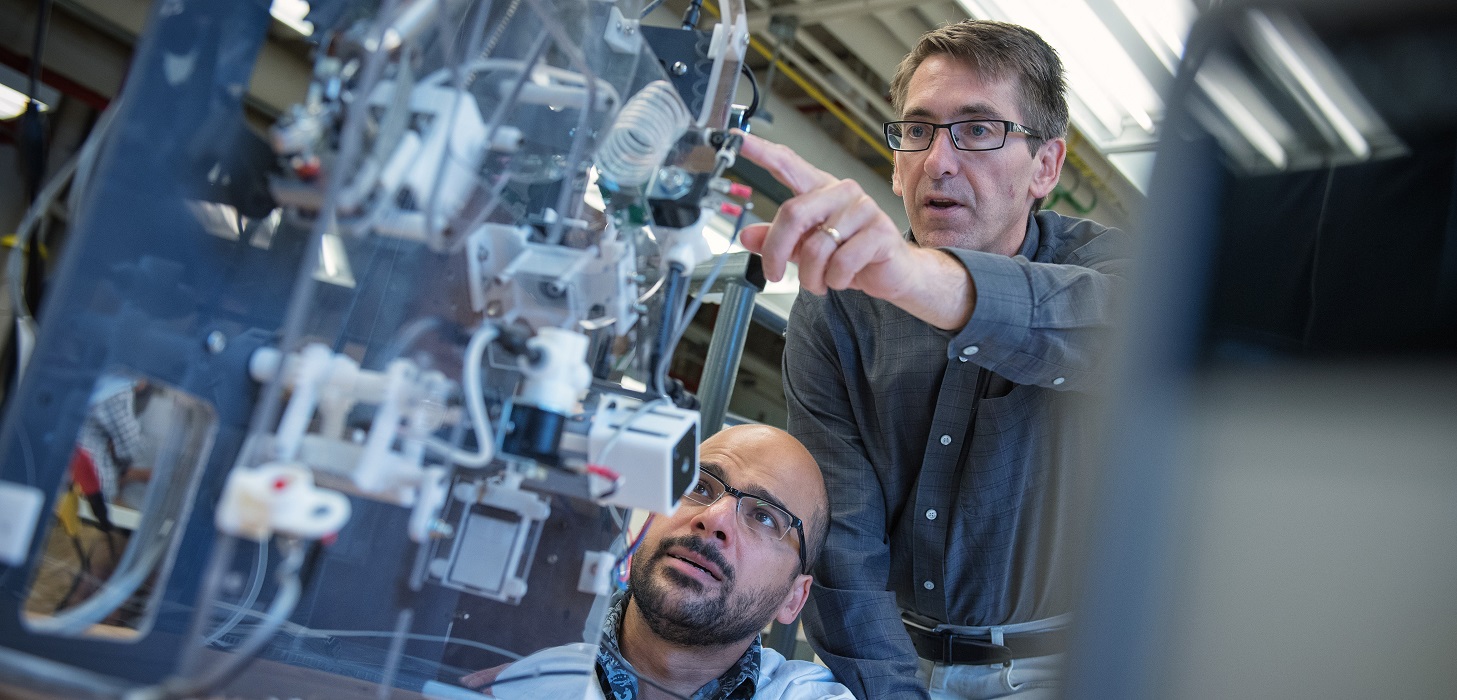
Professor James Olson with post-doctoral research fellow Hayder Salem in the Pulp and Paper Centre lab.
Established through decades of equal parts inspiration and perspiration, Applied Science’s research strengths — clean energy, advanced manufacturing, digital technologies, forest bio-economy, health, mining, transportation, urban systems and water — came to fruition with the right combination of people and place.
Within the context of the Faculty’s strategic plan, ENGAGE 2020, and under the leadership of James Olson (BASc ’91 ENPH, PhD’96 MECH), P.Eng., associate dean for research and industrial partnerships, Applied Science’s research enterprise is taking a new focused approach.
“The Faculty is committed to honing our research strengths, assuming global leadership, expanding the boundaries of professional practice and accelerating knowledge mobilization to benefit society,” says Olson. “We have a bona fide strength of faculty across disciplines who demonstrate a lifetime commitment to their chosen fields and are dedicated to making a positive difference for society.”
Olson’s own career speaks to this point. With a childhood immersed in British Columbia’s breathtaking natural beauty, the forest occupies a special place in his past. Through his research, it is set to play a vital role in a more sustainable future for us all.
Olson, a professor in the Department of Mechanical Engineering, is a member of the Forest Bio-Products Institute at UBC. The Institute brings together a multidisciplinary research team, working collaboratively with a single goal in mind: to advance the world’s bio-economy, an economy based on renewable biological resources.
The Institute couldn’t have been formed at a more critical time. As the world’s population booms and the middle class in countries such as China and India rapidly expands, our consumption of nonrenewable resources is skyrocketing — causing irreversible damage to our planet.
The Institute, however, is maximizing British Columbia’s natural resource advantage to lead the bio-revolution: extracting high-value products from bio-mass, an abundant material sourced primarily from residual and waste products from BC’s forest industry, to create alternative and sustainable materials, energy and chemicals.
Olson calls the Institute’s researchers the “superhero team” who have already spurred innovation in the bio-economy. Professor Paul Watkinson, P.Eng., of UBC’s Chemical and Biological Engineering (CHBE) Department and his team, for example, are working on developing and testing high-quality synthetic gas, or “syngas,” derived from biomass, using cutting-edge technology at the UBC Pulp and Paper Centre.
This renewable source of power has the potential to replace natural gas and run our future fuel cells.
Assistant Professor Heather Trajano, also of CHBE, is performing research that supports the Forest Products Association of Canada’s assessment that pulp, paper and saw mills could produce new, high-value bioenergy, biochemical and biomaterials — and its challenge to generate an additional $20 billion in economic activity by 2020. The goal of her research is to make large-scale bio-refineries a reality.
Olson has long been driving innovation in the bioeconomy and beyond. Following revolutionary energy saving developments in pulp and paper industry technology, Olson currently works with Pulp and Paper Centre Director & CHBE Professor Mark Martinez, P.Eng., to formulate a lightweight, low-density cellulose material from micro- and nanofibres — part of a new class of “bio-materials.” And Institute scientist Professor Frank Ko, of Materials Engineering, is developing new materials of this kind.
Bio-materials have the potential to replace fossil fuel materials and have a wide and exciting range of applications, from soundproofing and insulation to advanced cosmetics and high-strength turbine blades, and even to bio-compatible scaffolds for 3-D printing of human tissue.
These are a few of the projects being initiated by the Forest Bio-Products Institute researchers — and add to those programs such as the new Master of Engineering Leadership in Green Bio-Products to train and educate the next generation of bio-economy innovators.
The BC forest is intimately woven into the fabric of our province, and Olson is optimistic about its potential — a potential that the Institute is harnessing to bring about a greener future. “It’s an exciting time to be part of the bio-revolution,” he says, “and to be part of the forest industry.”
More information about the Forest Bio-Products Institute is available at www.fbp.ubc.ca
Re-printed from Ingenuity, Faculty of Applied Science News, issue 36. View full issue.